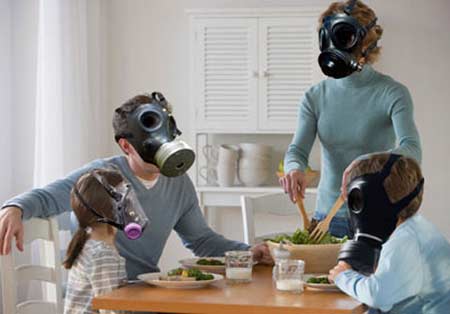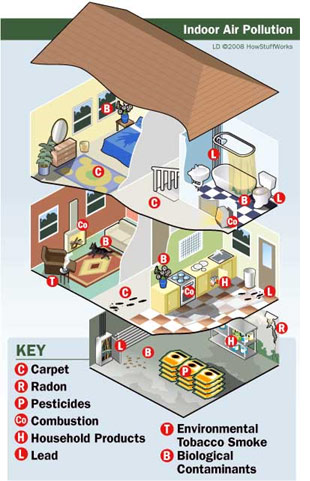Is your home poisoning you?
The air we breathe leaves much to be desired. Coal plants belch harmful CO2, 18-wheelers spew filthy exhaust and cows add methane to the mix. Sometimes just looking out your window at all the pollution may be enough to make you shun the outdoors.
image charles and hudson
But what's inside may be even worse. Indoor air pollution, the degradation of indoor air quality by harmful chemicals and other materials, can be up to 10 times worse than outdoor air pollution. This is because contained areas enable potential pollutants to build up more than open spaces do. You can easily visualize this if you think about dumping a can of oil into the ocean versus dumping a can into your bathtub. The oil in the ocean will dissipate and be diluted within the massive volume of water. That same oil in your bathtub will linger because it has nowhere else to go. The same thing happens with pollutants released into a small enclosed area, like your home or office.
You may think indoor air pollution doesn't apply to you. After all, you live nowhere near a highway, farm or industrial plant. You don't smoke and you don't use a wood-burning stove. But indoor air pollution comes from some places you wouldn't normally think of, like your house, the land it's sitting on and everyday items you can purchase at the store. In addition, if you consider that people spend approximately 90 percent of their time indoors, and around 65 percent inside their homes in particular, you can see why indoor air pollution is an important issue.
Some of the side effects caused by indoor air pollution are little worse than those of the common cold, but long-term exposure can lead to a coma, lung cancer, and death. Got your attention, yet?
The odds are that you encounter at least one harmful chemical in your home every day. If not, you're not out of the woods just yet. Indoor air pollutants can be released at high levels in short bursts, like when you use spray paint, or at lower levels over time, like chemicals leaching out of your carpet.
Let's look at a few of the causes of indoor air pollution and see where they originate:
- Radon: often found in the bedrock underneath a home and in building materials
- Environmental tobacco smoke: the combination of smoke coming from the burning end of a cigarette, pipe or cigar, as well as the smoke exhaled by the smoker
- Biological contaminants: bacteria, mould, mildew, viruses, animal dander, dust mites, cockroaches and pollen. Many of these grow in damp, warm environments or are brought in from outside.
- Combustion: unvented gas space heaters, woodstoves, fireplaces and gas stoves emit carbon monoxide, nitrogen dioxide and small particles. More than 3 billion people worldwide continue to rely on solid fuels like wood and coal for their energy needs [source:
World Health Organization].
- Household products: paints, varnishes, hobby products and cleaning products all contain organic chemicals that are released during use and storage.
- Pesticides: 80 percent of most people's exposure to pesticides happens inside; measurable levels of up to 12 pesticides have been detected in indoor air.
The potential for harm from any of these pollutants depends partly on our individual sensitivity. The elderly, the young and those with compromised immune systems tend to be more susceptible. Ventilation also plays a role in how these pollutants harm you.
If fresh air frequently circulates throughout the area, the culprits won't have as much time to accumulate and reach dangerous levels. Open windows and doors when the weather is nice, and especially after a lightning storm when the air is cleaner.


